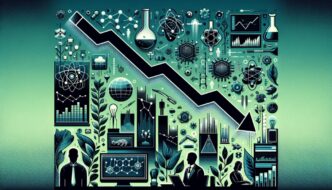Meta Title: Unexpected Decrease in German Industrial Production – Economic Implications | [Your Website Name]
Meta Description: Explore the unexpected decline in German industrial production in October. Learn about its impact on the economy, key sectors affected, and what it means for investors.
Introduction
Germany, often seen as the economic powerhouse of Europe, has recently experienced an unexpected downturn in its industrial production. Official data released on Friday revealed a 1.0 percent decrease in October, surprising analysts who had anticipated a growth of 1.0 percent. This follows a revised decline of 2.0 percent in September, raising alarm bells about the broader economic outlook for Europe’s largest economy.
In this article, we will delve into the factors contributing to this drop, its implications for the German economy and global markets, and what it means for investors and industry stakeholders.
Overview of the Decline
Key Statistics
- October 2023 Industrial Output: -1.0%
- September 2023 Revised Output: -2.0%
- Expectations for October: +1.0%
The unexpected decline is primarily attributed to poor performance in energy and automotive production, two key sectors that form the backbone of the German economy.
Sector Analysis
- Energy Sector
– A marked deterioration in energy production has occurred, influenced by rising costs and logistical challenges.
– Factors such as geopolitical tensions and reduced energy supply have played significant roles, creating an unfavorable environment for industry players.
- Automotive Industry
– The automotive sector, critical to Germany’s exports and economic health, also witnessed a downturn.
– Ongoing supply chain disruptions and semiconductor shortages have directly impacted production rates, leading to factory slowdowns.
Impact on the Economy
Broader Economic Implications
The decrease in industrial output signals deeper underlying issues within the German economy, potentially forecasting:
- Weakening GDP Growth: Analysts believe that recurrent declines in industrial production may hinder GDP growth, which has already been affected by inflationary pressures and reduced consumer spending.
- Increased Unemployment Risks: Industries under stress may resort to layoffs, intensifying the already challenging labor market.
- Diminished Export Power: Germany’s reputation as a leading exporter could be jeopardized as production stagnates, affecting trade balances and economic relations within the EU.
Market Reactions
Markets reacted promptly to the data release. The Euro weakened against major currencies, and stock indices exhibited volatility, signaling investor concern over future economic stability.
Key Considerations for Investors
Monitoring the Situation
Investors should remain vigilant and keep an eye on:
- Subsequent Industrial Data: Future industrial production reports will be critical in assessing whether this downturn is an anomaly or indicative of a longer-term trend.
- Government Response: Economic policy changes and government interventions aimed at stimulating growth will significantly influence market trends.
- Global Economic Context: International economic conditions, including the performance of major economies like the US and China, will also affect Germany’s industrial landscape.
Strategies for Investors
- Diversification: Expanding portfolios to include investments in sectors that may perform better can mitigate risk.
- Research and Analysis: Investing in companies with strong fundamentals and adaptability to changing market conditions is advisable.
- Active Monitoring: Regularly reviewing economic data and industry developments can guide timely investment decisions.
Benefits and Practical Tips
Navigating uncertain economic landscapes can be challenging, but understanding the nuances of market movements can yield advantages. Here are some practical tips:
- Stay Informed: Regularly follow economic news, reports, and analyses that provide insights into industrial performance and broader economic conditions.
- Engage with Financial Advisors: Collaborating with experts can offer personalized strategies that align with your investment goals during volatile periods.
- Consider Long-Term Investments: Rather than making impulsive decisions based on short-term data, maintain a focus on the bigger picture.
Conclusion
The surprising decline in German industrial production is emblematic of the challenges facing Europe’s largest economy. As sectors such as energy and automotive face pressures, the implications extend far beyond just production figures; they could have lasting effects on employment, GDP growth, and export performance.
As the economy navigates through this decline, it is essential for all stakeholders—investors, consumers, and policymakers—to stay informed and adaptable. The coming months will undoubtedly be crucial in shaping Germany’s economic trajectory, so keeping a close watch on industrial output and government responses may be the key to unlocking opportunities amidst uncertainty.
What to Watch For:
- Upcoming economic reports and forecasts from Destatis and other economic bodies.
- Government responses to bolster industries in crisis.
- Global economic conditions and their interconnected influence on the German economy.
By understanding the dynamics at play, individuals and businesses can better prepare for what lies ahead in Germany’s economic landscape.
—
Relevant Resources:
- Destatis – Industrial Production Reports
- Eurostat – Economic Indicators
- Trading Economics - Germany Economic Forecast
—
By following these strategies and staying informed about the latest economic developments, stakeholders can navigate the current landscape effectively and position themselves for future opportunities.






